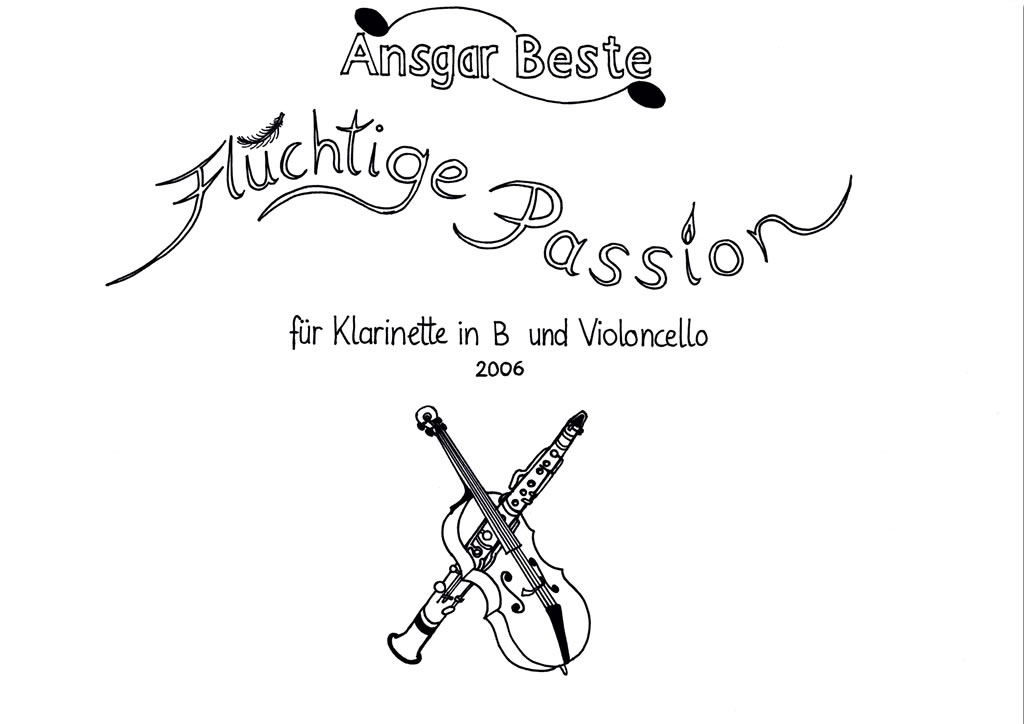← Danse Macabre (Macabre Dance)
Flüchtige Passion (Fleeting Passion)
| Setting | Clarinet in Bb and cello. | |
| Period of creation | 2006-05-13 to 2006-10-05, revision: 2006-11-07 + 11. | |
| Duration | 7 min. | |
| Commission / occasion | Commissioned by the Department of Contemporary Music at the University of Music Franz Liszt Weimar (Ger). | |
The “Fleeting passion” for clarinet in B and cello wants to obtain an emotional impact with the means of New Music as well as with a strict and complex construction: whilst longing emotions escalate from an empty absurdity to an eruption in the first part, a mental appeasement leads to satisfied calmness in the second part.
Cello (part I) and clarinet (part II) act alternately as leading voice each with 3 stylistic devices for the design: monody, flageolet glissando and trills in the cello, melody in two voices, tremolo ritardando and multiphonic in the clarinet. For the multiphonics as transparent sounds as possible were chosen (regarding the intervals) and composed with the criteria of increasing clarity.
The tone pitch progress was generated with the help of polynomials. Part I begins in the extreme depth, the secondary voice (cl.) pushes the leading voice (vc.) up to an insistent mergence on the climax of “f sharp3” in the end. In parallel to this even the 3 stylistic devices of the cello internally attain a mergence.
The passion is intensified by a distinct shortening of the pauses and the monodic parts simultaneously to an augmentation of the lamenting flageolet glissando.
Part II starts with the top note “f sharp3“, the secondary voice (now vc.) pushes the leading voice (cl.) again, down to the lowest register. But here the stylistic devices don’t begin in mergence, but unmask immediately the fragility of blind passion.
By the sound strategy and the shortening of the multiphonics as well as by the augmentation of the pauses and melodic parts the tranquilisation is amplified.
Altogether the cello represents the heart and the clarinet the motor which pushes the heart at first but calms down just very slowly after the emotional eruption.
The dynamic development proceeds according to the tone pitch progress from “ppp” to “fff” und back again. The overall high percentage of extremely quiet dynamics grants the passion its fleeting character.
As tone material for the secondary voices as well as for the monody and the melody in two voices of the leading voices an all-interval serial was chosen which begins with a small second, a small sixth and a small seventh and thereby expresses the longing prevailing mood. In both parts the serial develops out of a single tone and disappears there again.
The other elements range quasi-chromatically on the edge of the tone pitch framework. The flageolet glissandi proceed according to their own systematics, always with “f sharp” as a central tone.
For the sound strategy the (traditional and new) playing techniques were set in such a way that part I develops from noisy sounds to particularly intensively sounding tone pitches and part II in the opposite direction. Only the “pression” of the cello at the beginning of part II as a brutal forerunner of the collapse forms an exception. The cello sounds rich in harmonics in the end create a transfigured final impact.
Rhythmically the secondary voices conform with a complex matrix and even the main voices follow strict legalities. In every voice the motional density reaches its climax by achieving the top respectively the lowest pitch. Here even the length of the subsections is shortest and the all-interval serial most complete. In the following constriction of the tone pitch space the interior tension is enhanced by a motional decrease, by a prolongation of the subsections as well as by a tonal reduction of the all-interval serial.
The form operates with the proportions of the golden section on different levels: both between the parts I and II and within them.
| 2006-11-07 | Shizuyo Oka and Åsa Åkerberg (ensemble recherche) University of Music Franz Liszt Weimar (Ger) – workshop |
